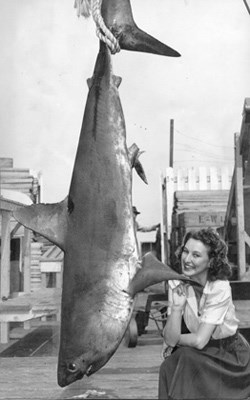? NEWS! at Presentation House Satellite Gallery, 560 Seymour Street, 2nd Floor, Vancouver. For more info visit satellitegallery.ca.
PHOTOGRAPHS endure.
Video is more revealing and audio can be more telling, but for some reason a single image marking 1/24th of a second often remains the most evocative, the most lasting.
Presentation House Gallery's satellite location in Vancouver is currently packed with newspaper images ranging from riots to newsies hocking papers declaring peace in 1945, to a member of legendary comedy group Monty Python escaping his makeshift cage.
"We're interested in art issues but also the wider life of photographs," explains Helga Pakasaar, the curator of the exhibit.
Pakasaar waded through boxes of Vancouver Sun and Province photographs dating back to the 1880s before deciding on 500 distinct shots for the exhibit.
Many of the photographs had never been filed following publication. Other pictures were unearthed from bizarre categories like Asphyxiation or Asian Children, according to Pakasaar, who says the collection represents the end of an era.
Kodachrome was the film of choice for many photojournalists, as well as the inspiration for songwriter Paul Simon, who rhapsodized about its ability to capture the greens of summer. Kodachrome, and virtually every other type film, has now fallen to the wayside as a casualty in the relentless march of digitization.
"The owners of the company aren't quite sure what to do with all this material," she says, describing the million-picture archive in the Vancouver Sun and Province vault.
That transition to digital has fascinated Pakasaar, who chose photographs exclusively from the analogue era. Spanning more than a century, Pakasaar finds the photographs represent a distinct period for both newspapers and photography.
"With digitization everyone's always thinking of ways to reduce space or to find ways to make paper objects disappear. . . . This is an interesting moment in news media in general and specifically newspapers: you have an online presence and a paper presence."
The collection includes pictures from Vancouver's 1938 post office riot, depicting a violent struggle between police and unemployed protesters.
The story of the Depression is told in stark black and white photos showing the weathered faces of itinerant workers as well as the shacks that once dotted Vancouver's shores.
There are also images of unrest closer to home, including youth fleeing in the night following the Halloween riot at Edgemont in the late 1960s.
But while the collection emphasizes many events of historical importance, there are also pictures with more dubious news value, such as cheerleaders, girls with hula hoops, and a water skiing squirrel.
Pakasaar also focuses on many of the famous faces to come through Vancouver, such as the great American writer and humorist Mark Twain.
"He came to Vancouver and he had a very bad cold so he was recuperating in the Hotel Vancouver and there's a photograph of him lying in bed in a big white blanket with a newspaper on top," she says.
Other shots capture The Beatles on the run, Frank Sinatra on stage, Marilyn Monroe with a First Nations chief, and Elvis Presley.
Some images are more disturbing, such as shots of slain Playboy centrefold Dorothy Stratten.
"There are strange photographs of her that have cropped up that provide insights into her story and what her social scene was like. Way before she was murdered there were already, one could say, clues," she says.
Between cityscapes and street scenes, the collection also delves into familiar political faces and familiar campaigns.
Most of the pictures are black and white 8 x 10s, but a few images break from that mould.
"Some of the prints are larger because photographers who wanted to get the attention of editors . . . would try to make larger prints so they would stand out more," she says.
While the endurance of digital images is untested, Pakasaar is adamant that the analogue photos be preserved.
"It's an amazing collection of historical information that would be horrible if it didn't last in the world," she says.



